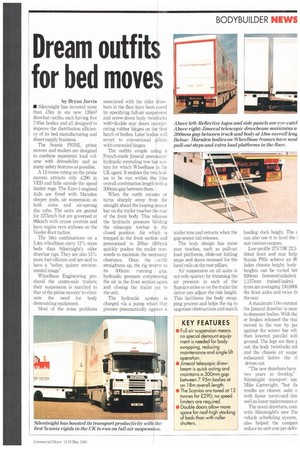Dream outfits for bed moves
Page 19

If you've noticed an error in this article please click here to report it so we can fix it.
by Bryan Jarvis
• Silentnight has invested more than 1:5rn in six new 126m3 drawbar outfits, each having five 7.95m bodies and all designed to improve the distribution efficiency of its bed manufacturing and direct supply business.
The Scania P93ML prime movers and trailers are designed to combine maximum load volume with driveability and as many safety features as possible.
A 12-tonne rating on the prime movers attracts only .C290 in VED and falls outside the speed limiter regs. The EuroI-engined 4x2s are fitted with Marsden sleeper pods, air suspension on both axles and air-sprung day cabs. The units are geared for 127km/h but are governed at 961un/h with cruise controls and have engine revs styluses on the Veeder-Root tachos.
The 18m combinations on a 5.4m wheelbase carry 12% more beds than Silentnight's older drawbar rigs, They are also 15% more fuel efficient and are said to have a "softer, quieter environmental image".
Wheelbase Engineering produced the centre-axle trailers; their suspension is matched to that of the prime movers' to eliminate the need for body demounting equipment.
Most of the noise problems associated with the older drawbars in the fleet have been cured by specifying full-air suspension and screw-down body twistlocks with. double rear doors incorporating rubber hinges on the first batch of bodies. Later bodies will revert to conventional pillars with concealed hinges.
The outfits couple using a French-made Jimecal pneuxnatrcl hydraulic extending tow bar systern for which Wheelbase is the UK agent. It enables the two bodies to be run within the 18m overall combination length with a 300mm gap between them.
When the outfit corners or turns sharply away from the straight ahead the looping sensor bar on the trailer touches the rear of the front body This releases the hydraulic pressure holding the telescopic towbar in the closed position. Air which is trapped in the front section and pressurised to Mbar (300psi) quickly pushes the trailer rearwards to maintain the necessary clearance. Once the outfit straightens up, the rig reverts to its 300mm running gap, hydraulic pressure compressing the air in the front section again and closing the trailer up to the unit.
The hydraulic system is charged via a pump wheel that presses pneumatically against a trailer tyre and retracts when the gap sensor rail releases.
The body design has some near touches, such as pull-out load platforms, slide-out folding steps and doors recessed for the hand rails on the rear pillars.
Air suspension on all axles is not only quieter; by trimming the air pressure in each of the Scania's axles or on the trailer the driver can adjust the ride height. This facilitates the body swapping process and helps the rig to negotiate obstructions and match loading dock height. The can also use it to level the suit various cargoes.
Low-profile 275/70R 22.5 fitted front and rear help: Scania P93s achieve an K. laden chassis height: body heights can be varied het 920nun (lowered/unladen) 1,157mm (raised/laden). tyres are averaging 150,000li the front axles and twice th the rear.
A maximum 1.0m extensi the jimecal drawbar is nece to demount bodies. With the er brakes released the trai moved to the rear by pu against the sensor bar wh: then lowered parallel witl ground. The legs are then r out, the body twistlocks rel and the chassis air suspe exhausted before the ri driven out.
The new drawbars have two years to develop," Silentnight transport ma: Mike Cartwright, but th, results are cleaner, safer o with faster turnround tirn well as lower maintenance o The novel drawbars, corn with Silentnight 's new Pai vehicle scheduling system, also helped the compan reduce its unit cost per deliv
































































































































